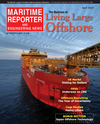
Page 16: of Maritime Reporter Magazine (April 2015)
Offshore Edition
Read this page in Pdf, Flash or Html5 edition of April 2015 Maritime Reporter Magazine
MANAGING RISK are various other challenges that can dis- can occur that can leave a shipper with impacted the overall port infrastructure and provide training to masters, chief rupt supply chain operations for global limited options. For example, last No- by triggering temporary closings of oth- engineers and chief mates to ensure that businesses. vember it was revealed that OW Bunker, er Japanese ports. operations are carried out in a safe and
Political and social upheaval can di- a large shipping fuel supplier, was vic- effective manner.
rectly and indirectly impact the supply timized by a $125 million fraud perpe- The Human Element chain. Bomb threats, introduction of bio- trated by employees of a subsidiary. That Ultimately, ships and trade do not Education and Preparedness logical agents, mining of ports, and at- theft, along with a separate $150 million depend on vast machines – but on the There are many risks involved in trans- tacks by suicide boats can affect a port loss on bad risk management, caused the people who run them. When considering porting cargo from point A to point B in with little notice. Domestic turmoil can company to close its doors overnight, re- the potential for disruption and loss on a reliable and timely fashion. They range also result in the banning of internation- quiring shipping operators to determine the seas, it’s important to remember the from traditional ones in plain view, such al shipping, such as what happened in how they were going to fuel their ships. crucial role that human behavior plays in as congested ports, to newer, insidious
Ukraine last year because of safety and Over the years, natural catastrophes the shipping industry. Well-trained of? - threats arising from weaknesses in cyber security concerns. It can also create an have caused severe disruptions in the cers and crews are the voyage’s greatest security. By becoming educated about environment that invites criminal activ- supply chain. The tsunami that struck assets, and without their high level of these risks, appropriate steps can be ity, including the stealing of freight from Japan in March 2011 created impacts on competency, industry losses would be taken to mitigate damages or losses that warehouses. This is a less direct but still shipping that were both wide-ranging greater. An investment in them is nec- may occur from untimely disruptions.
signi? cant impact of social unrest. and long-lasting. The disaster caused essary both for ensuring safe and ef? -
Sudden and unexpected developments direct damage to affected ports and also cient transport and to develop and retain skilled manpower.
Leveraging Global Expertise
The Author
Efforts to effectively mitigate global risk require access to a team of knowl-
Captain Andrew Kinsey is the senior edgeable global risk consultants on the marine risk consultant with Allianz Risk front lines evaluating the supply chain in
Consultants, a worldwide organization the most demanding environments, such offering risk management consulting as LNG module shipments out of China, and loss prevention reviews for hull, heavy machinery exports from Germany cargo and inland marine risks, covering or oversized high-value cargo entering exposures as varied as pleasure craft, or leaving the U.S. Industry experts, yachts, ports, terminals and every imag- such as those from Allianz, can also con- inable vessel.
duct assessments of shipping processes
CLARIFICATION
In the interview with Adm. Zuku- nft for the March 2015 edition, it was stated that the Coast Guard was in the process of implementing a ? nal rule on ballast water technology. In fact, the
Coast Guard published its ballast water discharge standard regulation in March 2012. At that time, the Coast Guard anticipated that implementation of a
U.S. type approval process would take at least three years. In July 2012, the
Coast Guard assessed and accepted an independent laboratory to carry-out the type approval testing of ballast water management systems designed to meet the ballast water discharge standard. A second independent laboratory was ac- cepted in 2013. In 2014, several man- ufacturers began testing their ballast completes the test evaluation of its bal- water management systems at these last water management system with an independent laboratories. The Coast accepted independent laboratory, the
Guard anticipates receiving type ap- Coast Guard will review the results. If proval applications from those manu- all requirements are met, Coast Guard facturers in 2015. Once a manufacturer type approval will be granted. 16 Maritime Reporter & Engineering News • APRIL 2015
MR #4 (10-17).indd 16 MR #4 (10-17).indd 16 4/2/2015 12:11:58 PM4/2/2015 12:11:58 PM

 15
15

 17
17
